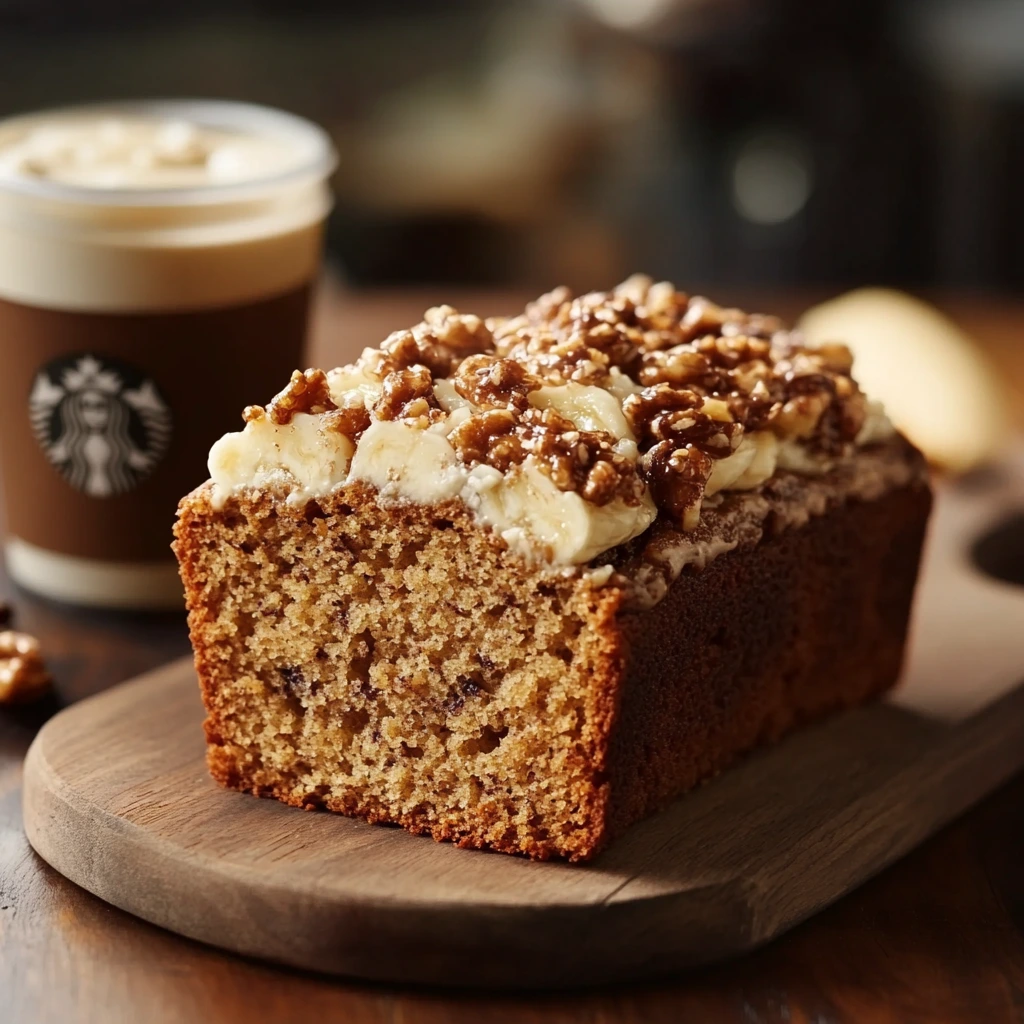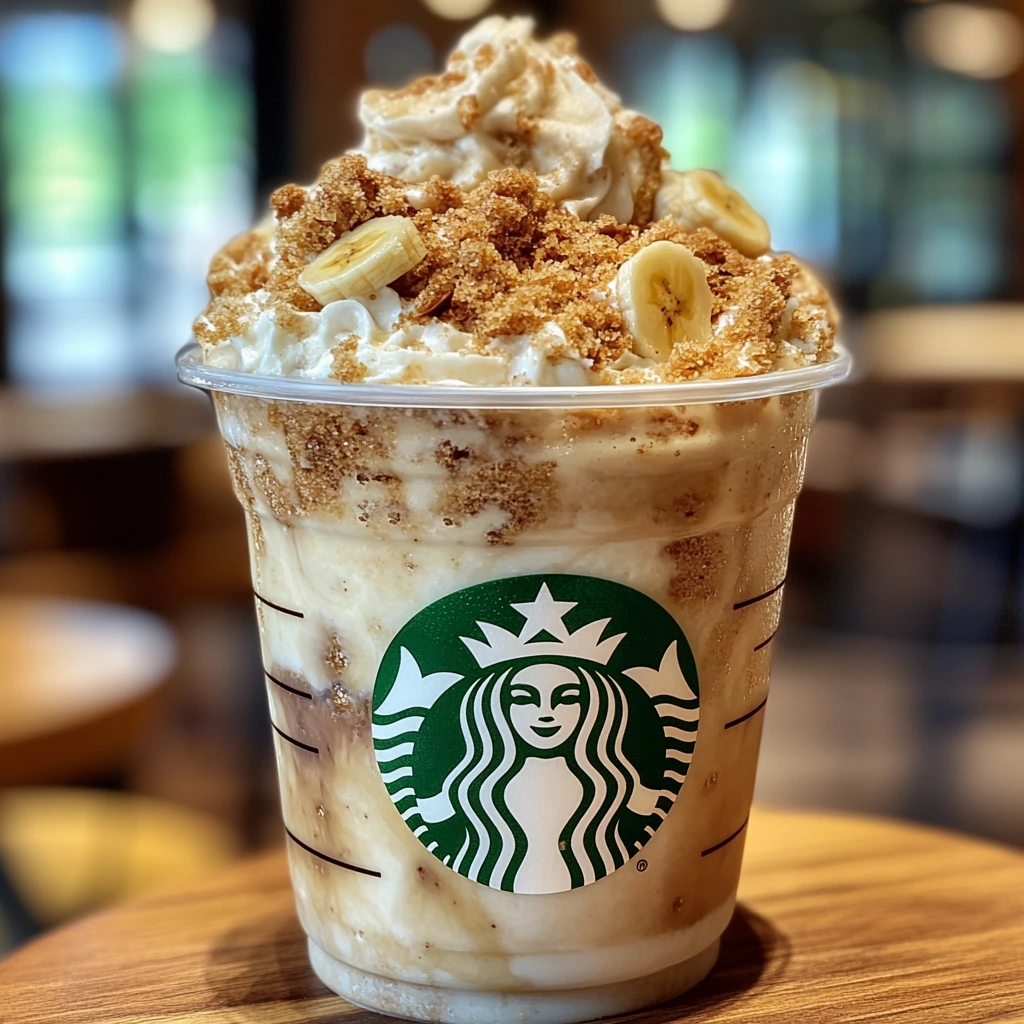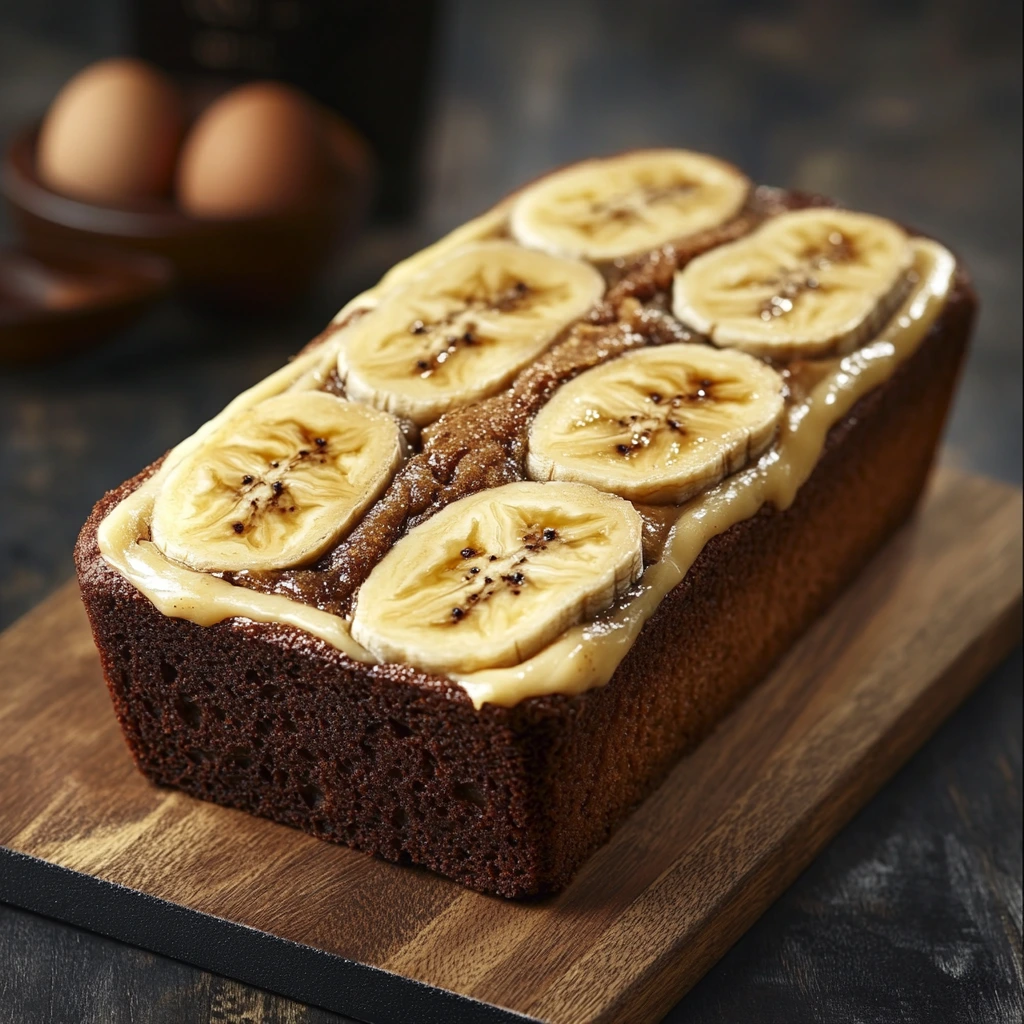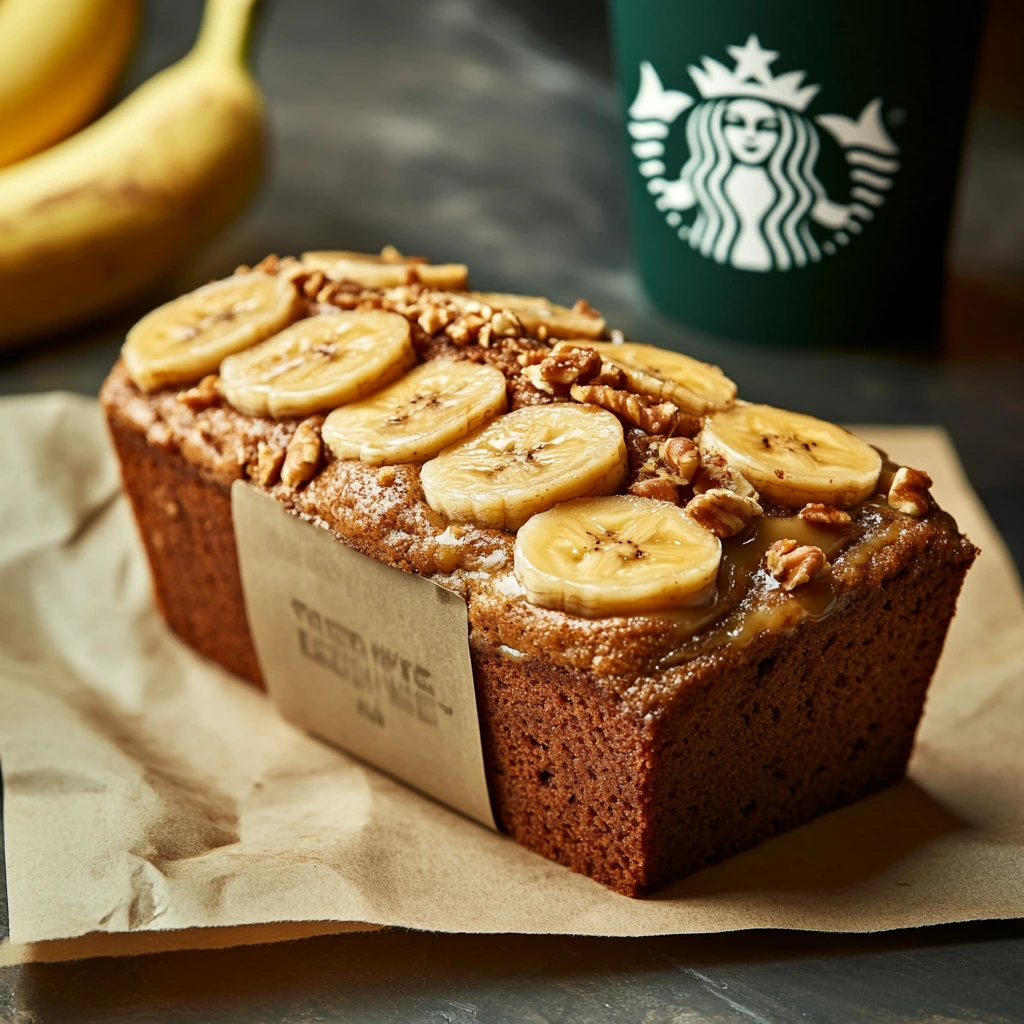Starbucks is known for its variety of baked goods, and one of the most popular treats on their menu is the banana bread. It’s a moist, flavorful option that many customers reach for when they’re craving a quick snack or a sweet accompaniment to their coffee. But with so many people becoming more health-conscious, the question arises: Is Starbucks banana bread actually good for you?
In this post, we’ll take a closer look at the nutritional content, ingredients, and potential health benefits or drawbacks of this beloved bakery item. Whether you’re watching your calorie intake, trying to avoid processed sugars, or simply looking for a guilt-free snack, we’ll help you decide if Starbucks banana bread fits into your diet. Let’s dive in and find out whether it’s an occasional indulgence or a reasonable treat for your daily routine!

What Are the Key Ingredients in Starbucks Banana Bread?
Starbucks banana bread is a favorite among many, thanks to its deliciously moist texture and rich banana flavor. But what exactly is in this popular treat? Let’s break down the key ingredients that make up Starbucks’ banana bread.
Common Ingredients Found in Starbucks Banana Bread
The main ingredients in Starbucks banana bread are simple yet effective in creating its signature taste. They include:
- Bananas: Ripe bananas are the star ingredient, providing the bread with its distinct flavor and natural sweetness. Bananas are also rich in potassium, fiber, and other essential vitamins, contributing some nutritional value.
- Flour: All-purpose flour is used as the base for the bread. While it gives the bread its structure, it also adds carbohydrates, which contribute to its calorie content.
- Sugar: Regular white sugar is added to sweeten the bread, making it more indulgent. Sugar also plays a role in the texture, helping to create that perfect moist crumb.
- Eggs: Eggs act as a binder, holding all the ingredients together while also adding protein and healthy fats to the bread.
- Butter or Oil: These fats contribute to the richness of the bread, making it soft and tender. They also enhance the flavor, though they do add to the calorie count.
- Baking Soda: This ingredient acts as a leavening agent, helping the bread rise during baking. It also contributes to the slight “bite” of the bread’s texture.
- Vanilla Extract: For added flavor, vanilla extract is used. It complements the natural sweetness of the bananas and enhances the overall taste.
These are the basic ingredients that form the bulk of Starbucks’ banana bread. Together, they create a treat that’s undeniably comforting and flavorful.
Are There Any Unhealthy Additives or Preservatives?
While the primary ingredients in Starbucks banana bread are relatively straightforward, there are a few additives and preservatives used to ensure the product’s freshness and consistency, for more details clic herehttps://quickyrecipes.com/pumpkin-banana-loaf/
- Preservatives: Depending on where you’re located, Starbucks banana bread may contain preservatives such as calcium propionate or sodium benzoate. These are commonly used in the food industry to prolong shelf life and prevent mold growth. While they are generally considered safe by food authorities, some health-conscious consumers prefer to avoid them in favor of fresher, preservative-free options.
- Artificial Flavors or Colors: Some variations of banana bread, especially those in larger food chains, may contain artificial flavors or color additives. It’s important to read the ingredient list on packaging if you want to avoid these. Starbucks, however, tends to focus on more natural ingredients, so artificial additives are unlikely to be present.
Healthier Alternatives to Common Ingredients
If you’re looking for ways to make Starbucks banana bread a bit healthier or want to replicate it at home, there are some swaps you could consider:
- Whole Wheat Flour: Substituting whole wheat flour for all-purpose flour would increase the fiber content and provide more vitamins and minerals, making the bread a bit more nutritious.
- Natural Sweeteners: Replacing white sugar with natural sweeteners like honey, maple syrup, or coconut sugar can reduce the glycemic index of the bread, making it a healthier option for people looking to control their blood sugar levels.
- Coconut Oil or Avocado: Instead of using butter or vegetable oil, you could try swapping in coconut oil or mashed avocado to reduce saturated fats and introduce healthier fats into the bread.
- Egg Substitutes: For those following vegan or egg-free diets, flaxseed meal or applesauce can replace eggs while maintaining the bread’s moisture and texture.
By understanding the ingredients in Starbucks banana bread, you can make an informed decision about whether it aligns with your dietary preferences or if you’d prefer a healthier alternative.
Nutritional Breakdown of Starbucks Banana Bread
If you’re wondering whether Starbucks banana bread is a healthy snack, it’s important to take a closer look at its nutritional content. While it’s undeniably tasty, understanding the calorie count, macronutrient breakdown, and sugar content can help you make a more informed decision. Let’s dive into the specifics.
How Many Calories Are in Starbucks Banana Bread?
One of the most important factors when evaluating the healthiness of any food is its calorie count. A standard serving of Starbucks banana bread, which is typically a slice weighing around 90 grams, contains approximately 420 calories.
- Calories from Fat: Of those 420 calories, a significant portion comes from fats (due to the butter or oil used in the recipe). This gives the bread its moist, rich texture but also increases its calorie density.
- Portion Size: It’s worth noting that this calorie count is based on a single slice of banana bread. If you’re mindful of your daily calorie intake, it’s important to keep portion sizes in check, as the bread can quickly add up if you’re having multiple slices throughout the day.
For comparison, a slice of homemade banana bread might have fewer calories depending on the ingredients, but the store-bought version typically has more because of added fats and sugars for enhanced taste and preservation.
What Are the Macronutrient Values?
Understanding the macronutrient breakdown of Starbucks banana bread can provide a clearer picture of its overall health profile.
- Carbohydrates: A slice of banana bread contains about 60 grams of carbohydrates, with the majority coming from the flour and sugar. While carbohydrates are an essential nutrient, it’s important to note that the bread is relatively high in simple carbs (from the sugar), which can cause a spike in blood sugar levels.
- Protein: Each slice provides around 4 grams of protein. While this is not a significant source of protein, it helps to balance out the carbohydrates and fats slightly.
- Fats: The fat content in one slice is about 16 grams, of which 3 grams are saturated fats. Saturated fats are often linked to health concerns when consumed in excess, so this is a factor to consider if you’re watching your fat intake.
- Fiber: The fiber content is relatively low, at about 2 grams per slice, which means it won’t do much to help with digestion or satiety compared to other whole-grain or fiber-rich snacks.
This breakdown indicates that while Starbucks banana bread provides a good amount of carbohydrates and fats, it’s not the most balanced option in terms of protein or fiber. It’s more of an indulgence than a nutrient-dense choice.
Is There Too Much Sugar in Starbucks Banana Bread?
Sugar is another crucial component of the nutritional breakdown. In a slice of Starbucks banana bread, the sugar content is around 19 grams, which includes both natural sugars from the bananas and added sugar.
- Natural vs. Added Sugars: While the bananas themselves provide some natural sugars, the majority of the sugar content comes from added white sugar. Added sugars are a concern for many health-conscious individuals since they contribute to excess calorie intake without offering much nutritional value.
- The Impact of Sugar on Health: A diet too high in sugar has been linked to various health issues, including obesity, diabetes, and heart disease. While consuming sugar in moderation is generally fine for most people, those watching their sugar intake may want to limit their portion sizes of Starbucks banana bread.
To make the bread a healthier option, you could consider opting for homemade banana bread with reduced sugar or using alternative sweeteners like maple syrup or coconut sugar to lower the glycemic impact.
Is Starbucks Banana Bread a Healthy Snack Option?
When it comes to choosing a snack, many people are looking for something that strikes a balance between taste and nutrition. Starbucks banana bread, with its rich, moist texture and sweet banana flavor, can be tempting, but is it a healthy snack option? In this section, we’ll explore whether Starbucks banana bread meets the criteria of a nutritious snack.

Banana Bread and Your Daily Nutritional Needs
While Starbucks banana bread may seem like a wholesome choice because of its banana content, it’s important to evaluate whether it meets your nutritional needs.
- High Carbohydrate Content: At around 60 grams of carbohydrates per slice, banana bread is primarily a carb-heavy food. While carbs are essential for energy, too many simple carbohydrates (such as those from added sugars and refined flour) can lead to blood sugar spikes and crashes, especially if consumed in large quantities.
- Low in Protein and Fiber: Protein and fiber are two crucial nutrients that help you feel full and satisfied. Unfortunately, Starbucks banana bread is low in both, with only 4 grams of protein and 2 grams of fiber per slice. This means it may not keep you full for long or help stabilize your blood sugar levels, which could leave you hungry soon after eating.
- Nutrient Density: Although the bread contains some beneficial nutrients like potassium from bananas, it lacks essential vitamins and minerals, making it less nutrient-dense than other snack options like fruit, nuts, or yogurt. If you’re looking for a snack that provides more vitamins and minerals, banana bread might not be the best choice.
Ultimately, Starbucks banana bread can serve as an occasional snack, but it doesn’t fulfill all of your daily nutritional needs. It’s best to pair it with a more nutrient-dense food to balance out your snack.
How Does It Compare to Other Starbucks Snacks?
If you’re choosing between Starbucks banana bread and other snack options at the coffeehouse, it helps to compare the nutritional profiles of different choices.
- Pastries and Sweets: Compared to other bakery items like croissants or muffins, Starbucks banana bread falls somewhere in the middle in terms of calorie content. A slice of banana bread contains about 420 calories, while some muffins can pack up to 500 calories or more. However, many muffins and pastries are higher in unhealthy fats, such as trans fats or hydrogenated oils. In this regard, banana bread might seem like a slightly better option.
- Protein-Packed Snacks: If you’re looking for something more filling and high in protein, options like Starbucks’ protein boxes or yogurt parfaits may be better choices. These snacks are typically higher in protein and fiber, which help with satiety.
- Healthier Alternatives: If your goal is to eat a healthier snack, consider options like the Whole-Grain Oatmeal or Under 200-Calorie Snacks available at Starbucks. These choices tend to have more fiber and fewer added sugars, making them more suitable for those looking to maintain a balanced diet.
In the context of Starbucks’ entire menu, banana bread is a middle-of-the-road option—indulgent but not necessarily the worst option in terms of health. It’s certainly better than some sugary pastries but doesn’t match up to more nutrient-dense snacks.
The Role of Banana Bread in a Balanced Diet
If you’re aiming for a balanced diet, it’s essential to be mindful of how indulgent snacks like Starbucks banana bread fit into your overall food choices.
- Occasional Treat: Given its calorie content and sugar levels, banana bread should be considered more of an occasional treat rather than a daily snack. A slice can fit into a balanced diet if consumed in moderation and paired with healthier options throughout the day, such as fruits, vegetables, and lean proteins.
- Balancing with Other Meals: If you decide to have a slice of banana bread, make sure your other meals and snacks for the day are nutrient-dense. For example, opt for a protein-rich breakfast like eggs or Greek yogurt, and make sure your lunch or dinner includes a good portion of vegetables, lean proteins, and healthy fats to balance out the sugar and carbs from the bread.
- Mindful Eating: Paying attention to portion sizes is also crucial. If you’re having a slice of banana bread with your coffee, consider choosing a smaller portion or pairing it with a beverage that’s lower in calories and sugar (like a black coffee or iced tea) to offset the calorie density of the bread.
Incorporating Starbucks banana bread into a balanced diet is possible if you take a mindful approach and enjoy it in moderation alongside other nutrient-dense foods.
Can Starbucks Banana Bread Fit Into Your Dietary Preferences?
Whether you’re following a specific dietary plan, have food sensitivities, or are just trying to eat more mindfully, it’s important to consider how Starbucks banana bread fits into your dietary preferences. In this section, we’ll explore whether this popular treat can work for those with various dietary needs and restrictions.

Vegan and Gluten-Free Considerations
If you follow a vegan or gluten-free diet, you might wonder if Starbucks banana bread is a suitable option. Let’s break it down:
- Vegan Considerations: Traditional Starbucks banana bread is made with eggs and butter, which makes it unsuitable for those following a vegan diet. However, Starbucks does offer a variety of vegan-friendly items on their menu, so if you’re craving banana bread, you could consider making a vegan version at home or finding alternatives at other bakeries that cater to plant-based diets.
- Gluten-Free Considerations: Unfortunately, Starbucks banana bread is not gluten-free, as it contains all-purpose wheat flour. For those with celiac disease or gluten sensitivities, it’s important to avoid this option. However, Starbucks offers a selection of gluten-free items, such as the Gluten-Free Coffee Cake or Gluten-Free Protein Boxes, that might be more suitable for your dietary needs. If you’re craving banana bread, you could also explore gluten-free recipes to make it at home using gluten-free flour.
For individuals with vegan or gluten-free preferences, Starbucks banana bread doesn’t quite fit the bill, but there are other options available that align better with these diets.
Portion Control and Serving Size
When it comes to enjoying Starbucks banana bread, portion control can make a significant difference in how well it fits into your dietary plan.
- Caloric Density: With around 420 calories per slice, a full serving of banana bread can be quite calorie-dense, especially if you’re trying to manage your calorie intake. However, if you’re looking to indulge in a sweet treat without overdoing it, one approach is to limit your serving size. You might consider sharing a slice with a friend or cutting it in half to save some calories for later.
- Pairing with Lighter Options: To balance out the calories and make the snack more filling, consider pairing a slice of banana bread with a lighter beverage like a black coffee or unsweetened iced tea. This can help keep your overall calorie count lower while still allowing you to enjoy the treat. If you’re having banana bread as part of a larger meal, ensure that your other food choices are lower in calories or packed with more vegetables, protein, or whole grains.
- Mindful Eating: Practicing mindful eating can also help you enjoy your banana bread while managing portion sizes. Paying attention to hunger cues and savoring each bite can make it easier to resist the temptation to eat more than you need.
Portion control and mindful eating are essential to making Starbucks banana bread a reasonable option, even for those with strict dietary goals.
Is it Safe for People with Health Conditions (e.g., Diabetes)?
People with certain health conditions, such as diabetes, need to be especially cautious when choosing foods that impact blood sugar levels. So, how does Starbucks banana bread stack up for those with diabetes or other related health concerns?
- Sugar Content and Blood Sugar Spikes: One of the biggest concerns with Starbucks banana bread for those managing diabetes is its high sugar content. With 19 grams of sugar per slice, this can lead to a spike in blood glucose levels, especially if consumed in large amounts. It’s important for individuals with diabetes to be aware of how sugary foods like banana bread can affect their health.
- Carbohydrate Load: Each slice of banana bread contains around 60 grams of carbohydrates. For someone with diabetes, it’s essential to track carbohydrate intake to prevent blood sugar spikes. It may be wise to save banana bread for a special occasion and enjoy it in moderation while balancing it with a low-carb meal or snack to mitigate its impact on blood sugar.
- Making Modifications: If you have diabetes and want to enjoy banana bread, consider making your own at home with healthier ingredients. You could reduce the sugar content by using a natural sweetener like stevia or monk fruit and use whole wheat or almond flour to reduce the glycemic index. Additionally, adding nuts (such as walnuts or almonds) could provide healthy fats and protein, which can help slow the absorption of sugar into the bloodstream.
For people with diabetes or blood sugar concerns, Starbucks banana bread should be enjoyed in moderation, and it might be best to explore alternatives or modifications to fit better within dietary restrictions.
Is Starbucks Banana Bread Good for You?
Determining whether Starbucks banana bread is “good for you” involves more than just evaluating its taste. It’s about understanding how it fits into your overall health and nutrition goals. While this treat is undeniably delicious, it’s important to consider the benefits and drawbacks of including it in your diet regularly. Let’s break it down and weigh the pros and cons.

Health Benefits of Starbucks Banana Bread
Despite being a sweet treat, Starbucks banana bread offers some benefits that may make it a worthwhile occasional indulgence.
- Bananas Are a Nutrient Powerhouse: One of the primary ingredients in banana bread is, of course, bananas. Bananas are rich in potassium, which is essential for heart health and maintaining proper muscle function. They also provide vitamin C, vitamin B6, and fiber, which can help support the immune system, improve digestion, and promote overall well-being. While the amount of banana in each slice may not provide an overwhelming dose of these nutrients, it does add some nutritional value to the bread.
- Energy from Carbs: The carbohydrates in banana bread, especially from the flour, provide a source of quick energy. This can be beneficial for people needing a mid-day pick-me-up or something to fuel them before a workout. However, it’s important to pair it with a balanced meal to avoid sugar crashes.
- Mood-Boosting Effects of Bananas: Bananas also contain tryptophan, an amino acid that helps the body produce serotonin, a neurotransmitter that regulates mood and happiness. This might help boost your mood and provide a sense of comfort when you enjoy your slice of banana bread.
While Starbucks banana bread does provide some health benefits, these are generally outweighed by its sugar and calorie content, especially if consumed in large portions or frequently.
Drawbacks of Starbucks Banana Bread
While the banana bread does have some positive nutritional elements, there are also several factors to consider when determining if it’s good for you in the long term.
- High in Calories and Sugar: A slice of Starbucks banana bread contains about 420 calories and 19 grams of sugar. The high sugar content comes from added sugars like white sugar, which can contribute to weight gain, blood sugar imbalances, and other health problems when consumed in excess.
- Low in Fiber and Protein: With only 2 grams of fiber and 4 grams of protein per slice, Starbucks banana bread doesn’t do much to support digestive health or satiety. This means that while it can fill you up temporarily, it won’t keep you full for long, and you may feel hungry again shortly after eating it. Fiber and protein are important for a balanced snack, as they help with digestion, fullness, and sustained energy levels.
- Saturated Fats: Each slice also contains about 3 grams of saturated fat, which contributes to the overall fat content. Excessive intake of saturated fats can negatively affect heart health by increasing cholesterol levels, so it’s important to monitor intake of such fats, especially if you already have risk factors for heart disease.
While the banana bread offers some perks, its high calorie, sugar, and fat content may limit its suitability as a regular snack, particularly for those concerned about their weight or overall health.
Can You Enjoy Starbucks Banana Bread in Moderation?
As with most indulgent treats, the key to making Starbucks banana bread “good for you” is moderation.
- Occasional Indulgence: Enjoying a slice of banana bread every once in a while as a treat is unlikely to have a significant negative impact on your health if it’s balanced with other nutritious foods throughout the day. It’s important to recognize that no single food item defines whether your diet is healthy or not—it’s the overall pattern of your eating habits that matters most.
- Balance with Nutrient-Dense Foods: If you’re indulging in a slice of banana bread, try to balance it with a meal or snack that’s rich in protein, fiber, and healthy fats. For example, pair it with a cup of Greek yogurt or a handful of nuts to help keep you fuller for longer and provide more nutritional value.
- Consider Healthier Alternatives: If you’re looking for a healthier alternative, you might consider baking banana bread at home using whole wheat flour, reducing the sugar content, or adding in ingredients like flaxseed, walnuts, or chia seeds for extra fiber and healthy fats. Some recipes even replace the butter and eggs with avocado or applesauce for a lighter version of the treat.
In conclusion, Starbucks banana bread can be a delicious treat to enjoy on occasion, but it should not be seen as a healthy, everyday snack. When consumed in moderation and balanced with healthier options, it can still be a part of a well-rounded diet.
Chef’s Note: A Treat to Enjoy in Moderation
As a chef, I always say that food is meant to be enjoyed—taste, texture, and enjoyment are at the heart of every dish. Starbucks banana bread is undeniably delicious, with its soft, moist texture and rich flavor. It’s the kind of treat that can bring comfort and a little bit of joy to your day. However, like many indulgent foods, it’s best enjoyed in moderation.
While it’s not the most nutrient-dense snack option out there, it does offer some benefits, like the potassium from bananas and the satisfying energy from carbs. The key is balance—pairing it with other nutritious foods and keeping portions in check will allow you to enjoy your slice without feeling guilty. After all, a treat every now and then is part of life’s pleasures.
So, savor that slice of banana bread when you want a sweet pick-me-up, but always remember that a healthy lifestyle is about finding balance, and it’s okay to indulge once in a while. Bon appétit!
